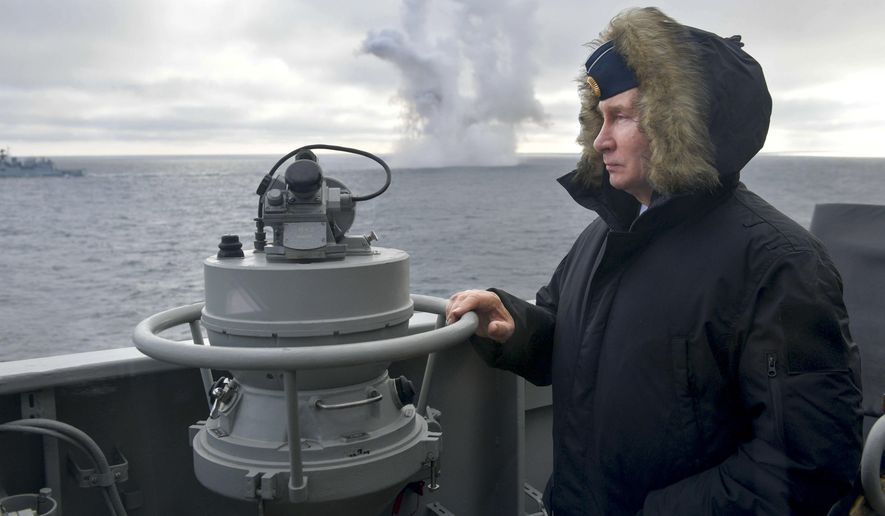Russia is using intelligence obtained from U.S. and European overflights under the Open Skies Treaty to plan future cruise missile strikes on infrastructure targets, Secretary of State Mike Pompeo revealed yesterday.
“Moscow appears to use Open Skies imagery in support of an aggressive new Russian doctrine of targeting critical infrastructure in the United States and Europe with precision-guided conventional munitions,” Mr. Pompeo said in a statement supporting President Trump’s announcement to withdraw from the 2002 treaty.
“Rather than using the Open Skies Treaty as a mechanism for improving trust and confidence through military transparency, Russia has, therefore, weaponized the treaty by making it into a tool of intimidation and threat,” he noted.
The Trump administration announced Thursday it will formally begin the process of withdrawing from the 34-nation Open Skies Treaty on Friday. The notification means the United States will end participation in the treaty in six months.
Mr. Pompeo said the United States would reconsider staying in the treaty if Moscow returns to full compliance.
“But without such a change of course from the Kremlin, our path will lead to withdrawal in six months’ time,” he said.
The treaty permits signatories to conduct surveillance flights over U.S. and other foreign nations’ territory to promote openness and transparency regarding military forces.
Mr. Pompeo’s disclosure of Russian targeting from treaty overflights followed a warning last year that Russia was deploying long-range land-attack cruise missiles on submarines and warships in the Atlantic.
Defense officials disclosed that the Russian navy’s long-range, precision-guided Kalibr cruise missiles will be deployed in the western Atlantic. The missiles allow Moscow to target the U.S. East Coast for conventional or nuclear attacks.
The new sea-based Kalibr deployments were expected to take place throughout 2019, according to officials familiar with intelligence reports of the Russian maritime operations who spoke on condition of anonymity.
The Kalibr, known as SS-N-30A by NATO, is a relatively new weapon showcased for the first time by Russian airstrikes in Syria that began in 2015. It has a range of between 930 miles and 1,550 miles.
That range would allow a Russian ship or submarine to target all U.S. cities while located 1,000 miles off the U.S. coast.
The Kalibr is one of two weapons systems Russia plans to use in any future strikes on the United States. The second is the advanced Kh-101 air-launched cruise missile that can be armed with either conventional or nuclear warheads.
In 2014, Russian strategic bombers practiced simulated cruise missile strikes on the United States from launch areas off the coast of Canada.
A year later, then-commander of the Northern Command, Adm. William Gortney, warned Congress that Russian long-range cruise missiles posed new threats to the United States.
“Russia is progressing toward its goal of deploying long-range, conventionally-armed cruise missiles with ever increasing stand-off launch distances on its heavy bombers, submarines, and surface combatants,” Adm. Gortney said.
The missile in question is Moscow’s KH-101, which U.s. military officials say is designed specifically to attack critical infrastructure targets such as electric power grids.
Mr. Pompeo said the threat to leave Open Skies is based on Mr. Trump’s strategy of assessing whether such treaties benefit U.S. national security interests. Moscow “flagrantly and continuously violated” the treaty for years, the secretary of state noted.
Russia denied access to treaty-allowed observation flights near a border with Russian-occupied occupied Georgian regions of Abkhazia and South Ossetia. The denials were part of an effort by Moscow to assert that the occupied territories are states independent of Georgia.
Moscow also designated a refueling air base in Russian-occupied Crimea in the Ukraine in a similar bid to solidify its control.
The Russian government also restricted Open Skies surveillance flights over the Russian enclave of Kaliningrad where Moscow is building up military forces that threaten NATO allies.
Mr. Pompeo noted that Russian officials have suggested that Kaliningrad is a base for short-range nuclear-tipped missiles targeting NATO.
The Russians also denied a 2019 overflight of a large Russian military exercise.
Another Russian violation up until 2017 was the denial of overflights related to movements by senior Russian officials and important persons.
“These periodic and shifting violations highlight Russia’s willingness for many years now, to restrict or deny overflights whenever it desires,” Mr. Pompeo said. “This strikes at the heart of the treaty’s confidence-building purpose.”
The pullout of the treaty follows Mr. Trump’s earlier jettisoning of the 1987 Intermediate-range Nuclear Forces Treaty over Russia’s deployment of a new ground-based cruise missile that U.S. officials said was banned by the treaty. The administration also appears on track to allow the 2010 New START treaty to expire in February over Moscow’s development of new strategic weapons that are not included in the treaty.
Mr. Pompeo also said the U.S. treaty withdrawal is the result of Russian actions toward arms control in general.
The pending withdrawal from Open Skies was criticized by arms control advocates who say the treaty was an important confidence-building measure between the United States, Europe and Russia.
“The Open Skies Treaty was meant to contribute to international security, but it has been twisted and perverted in its implementation and now serves Russian purposes inimical to that security,” Mr. Pompeo said.
Despite interest by European governments in keeping the treaty, Mr. Pompeo noted: “We are not willing, however, to perpetuate the treaty’s current problems of Russian-engendered threat and distrust simply in order to maintain an empty facade of cooperation with Moscow.”
• Bill Gertz can be reached at bgertz@washingtontimes.com.




Please read our comment policy before commenting.